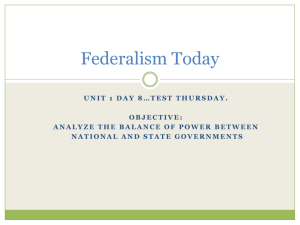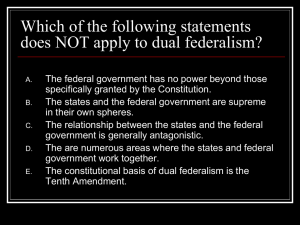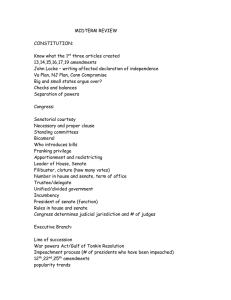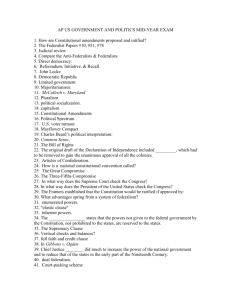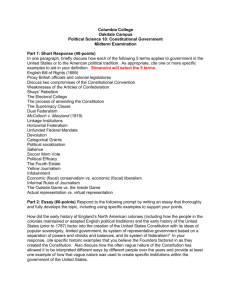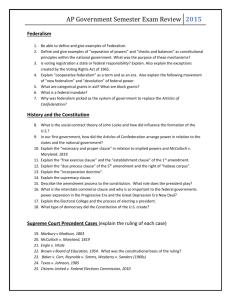Federalism - University of San Diego Home Pages
advertisement
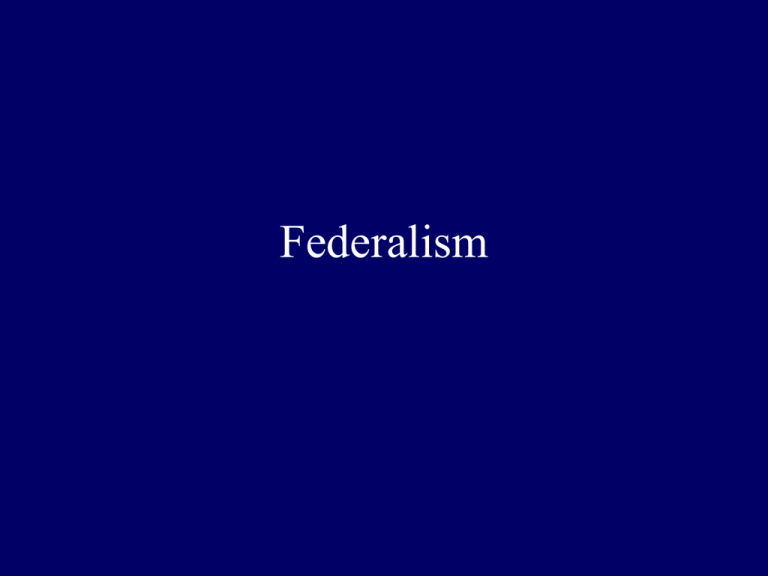
Federalism A note on usage: • Federalism refers to the fact that government authority is divided between the national and state governments. – “We have a federal system of government” • Weirdly, “the federal government” refers to the national government in Washington Federalism • • • Definition: Government where authority is divided between two or more distinct levels of government. Not a “Confederation” Not a “unitary” government Federalism in the Constitution • Empowering the states: • Senate (Article I Section 3) Senate • The Senate of the United States shall be composed of two Senators from each State, chosen by the Legislature* thereof for six Years; and each Senator shall have one Vote. • *(modified by the 17th amendment, 1913) Federalism in the Constitution • Empowering the states: • Senate (Article I Section 3) • Tenth amendment th 10 amendment • The powers not delegated to the United States by the Constitution, nor prohibited by it to the States, are reserved to the States respectively, or to the people. Federalism in the Constitution • • • • Empowering the states: Senate (Article I Section 3) Tenth amendment “Full faith and credit” (Article IV Section 1) Full Faith and Credit Clause • Full Faith and Credit shall be given in each State to the public Acts, Records, and judicial Proceedings of every other State. • (Article IV Section 1) Federalism in the Constitution • • • • Empowering the states: Senate (Article I Section 3) Tenth amendment “Full faith and credit” (Article IV Section 1) • Empowering Congress over the states: • Commerce clause (Article I Section 8) Commerce Clause The Congress shall have Power To… regulate Commerce with foreign Nations, and among the several States… Article I Section 8 Federalism in the Constitution • • • • Empowering the states: Senate (Article I Section 3) Tenth amendment “Full faith and credit” (Article IV Section 1) • Empowering Congress over the states: • Commerce clause (Article I Section 8) • Supremacy Clause (Article VI) Supremacy Clause (Article VI) • This Constitution, and the Laws of the United States which shall be made in Pursuance thereof; and all Treaties made, or which shall be made, under the Authority of the United States, shall be the supreme Law of the Land; and the Judges in every State shall be bound thereby, any Thing in the Constitution or Laws of any State to the Contrary notwithstanding. Federalism in the Constitution • • • • Empowering the states: Senate (Article I Section 3) Tenth amendment “Full faith and credit” (Article IV Section 1) • Empowering Congress over the states: • Commerce clause (Article I Section 8) • Supremacy Clause (Article VI) Federalism in the Constitution • • • • Empowering the states: Senate (Article I Section 3) Tenth amendment “Full faith and credit” (Article IV Section 1) • • • • Empowering Congress over the states: Commerce clause (Article I Section 8) Supremacy Clause (Article VI) Congress’ enumerated powers (Article I section 8) Some of Congress’ other specific powers… • • • • • • • • • • The Congress shall have Power To lay and collect Taxes, Duties, Imposts and Excises, to pay the Debts and provide for the common Defence and general Welfare of the United States; but all Duties, Imposts and Excises shall be uniform throughout the United States; To borrow Money on the credit of the United States; To establish an uniform Rule of Naturalization, and uniform Laws on the subject of Bankruptcies throughout the United States; To coin Money, regulate the Value thereof, and of foreign Coin, and fix the Standard of Weights and Measures; To provide for the Punishment of counterfeiting the Securities and current Coin of the United States; To establish Post Offices and post Roads; To declare War, grant Letters of Marque and Reprisal, and make Rules concerning Captures on Land and Water; To provide for calling forth the Militia to execute the Laws of the Union, suppress Insurrections and repel Invasions; To provide for organizing, arming, and disciplining, the Militia, and for governing such Part of them as may be employed in the Service of the United States, reserving to the States respectively, the Appointment of the Officers, and the Authority of training the Militia according to the discipline prescribed by Congress; To make all Laws which shall be necessary and proper for carrying into Execution the foregoing Powers, and all other Powers vested by this Constitution in the Government of the United States, or in any Department or Officer thereof. Dual vs. Shared Federalism • Dual federalism: States and national government each have separate, mutually exclusive spheres of sovereignty – Maybe what some Framers had in mind • Shared federalism: States and national government have overlapping spheres of sovereignty – What evolved after the Civil War Shared federalism States only Shared National only Run elections Tax Coin money Health & safety Borrow money Make treaties Regulate in-state commerce Take property Make war Enforce laws Run post system Regulate interstate commerce Tax imports and exports Number of governments in America’s federal system (from Logic text p. 94) Type of government Number of governments National 1 State 50 County 3,033 Municipal 19,492 Township/town 16,519 School district 13,051 Special district 37,381 Other 89,527 Federalism = 50 Little Laboratories • Different state systems of government Different institutions of government • • • • • • Nebraska: unicameral, nonpartisan legislature Initiative: 14 states Recall: 18 states Legislative term limits: 15 states Professional legislatures: CA, MI, NY, PA Amateur legislatures: NH, MT, NV, UT California • Legislature: – 80 seats in Assembly – 40 seats in Senate • Executive: – Governor, Lt. Governor, Secretary of State, Attorney General, State Treasurer, State controller, State superintendent of public instruction, Insurance Commissioner---all separately elected • Judicial: – state Supreme Court, Superior Courts and Appeals Courts • Direct Democracy: – Initiative, Referendum, Recall Little Laboratories • Different state systems of government • Different laws and policies Different laws and policies • • • • • No income tax: 6 states No sales tax: 4 states Charter schools: 41 states School vouchers: 12 states Environmental laws: California strictest Changes to the Federal-State Relationship • Establishing supremacy of national laws – McCulloch v. Maryland (1819) – Gibbons v. Ogden (1824) • Courts limit national government’s regulation of the economy – Schechter Poultry Co. vs. US (1935) – NLRB vs. Jones & Laughlin Steel (1937) • New Deal and Great Society expand federal government’s control over local affairs • New Federalism • Recent court cases (US. v. Lopez) How can the federal government force the state governments to do what it wants them to? • Pre-emption legislation that asserts national supremacy over a whole policy issue • Grants-in-aid – Block grants, matching grants • Unfunded mandates – Crossover sanctions, Direct orders What are some policy debates over whether the federal or state governments have authority to act? • • • • Immigration enforcement Environmental regulations Education regulation Regulation of health care costs and health insurance • Abortion No Child Left Behind


